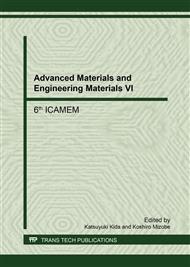p.192
p.197
p.202
p.207
p.212
p.218
p.224
p.229
p.235
Fractal Characterization Analysis in CNC Milling Aluminium Alloy
Abstract:
Based on the experiment of milling aluminium alloy (7075-T651), the relations between the fractal dimensions of cutting forces with machining parameters are studied. Cutting speed, feed speed and cutting depth are considered as the process parameters. The cutting force in milling aluminium alloy operation are measured and the fractal dimension are calculated using the algorithm of correlation dimension. From main effect plots the fractal dimensions of three directions of cutting forces are reduced with the increase of cutting speed and increased with the increase of feed speed and cutting depth. The mathematic models of fractal dimension of cutting force are developed using response surface methodology (RSM). The results of the ANOVA show that feed speed and cutting depth have remarkable influence to fractal dimension Dx and Dy, cutting speed and feed speed for Dz.
Info:
Periodical:
Pages:
212-217
Citation:
Online since:
August 2017
Authors:
Price:
Сopyright:
© 2017 Trans Tech Publications Ltd. All Rights Reserved
Share:
Citation:


